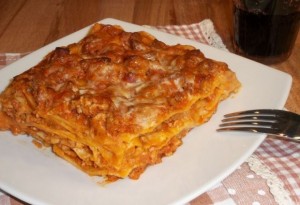Lasagne BolognesiBolognese Lasagna
Un po’ di storia:
In origine le lasagne non erano come le conosciamo oggi. Hanno le loro radici nell’età Romana e nell’antica Grecia. In quel periodo, le lasagne erano della pasta tagliata a quadrati, cotti in pentola e conditi con legumi e formaggio. Erano chiamate “lasana,” “lasanum,” o “lagana,” che sono parole latine. Queste parole vengano dal greco “laganon,” il cui significato è foglio grande e piatto di pasta tagliata a strisce. Questo tipo di pasta cominciò ad essere conosciuta come “lasagna” solo dopo il 1000 d.C.
Nel XIV secolo, Franceso Zambrini scoprì che quelle strisce di pasta potevano essere lasciate intatte e che si potevano creare degli strati con il formaggio. Nel 900, le lasagne erano un piatto popolare perché i ristoranti bolognesi iniziarono a farle per i clienti. Le lasagne non erano solo conosciute a Bologna: Nel 1935, Paolo Monelli ha messo le lasagne nel suo libro, “Ghiottone errante”.
Adesso le lasagne sono diventate un simbolo della cucina italiana nel mondo.
Ingredienti:
1. 500g di lasagne (vedi come fare la sfoglia emiliana)
2. 200g di parmigiano grattuggiato
3. 1 litro di besciamella
4. ragu’ di carne (vedi)

Preparazione:
Una volta pronto il ragù preriscaldate il forno a 170° ed iniziate ad assemblare le vostre lasagne: imburrate una teglia rettangolare, stendete un paio di cucchiai di ragù e foderate il fondo con la pasta, quindi coprite con qualche cucchiaio di besciamella.
Coprite poi con abbondante ragù e una spolverata di Parmigiano.
Coprire il tutto con altra pasta e procedete nello stesso modo per realizzare sei strati.
Per l’ultimo strato, mischiate il ragù e la besciamella rimasti, ricoprendo con il composto la pasta.
Una bella e abbondante spolverata di Parmigiano Reggiano e infornate il tutto per almeno 50-60 minuti.
Non appena le lasagne avranno formato la loro caratteristica crosticina sono pronte.
Lasciatele raffreddare per 10 minuti e servitele.
Come vino si abbina perfettamente il Lambrusco.A bit of history:
Originally, the lasagna was not as we know them today. They have their roots in ancient Greece and the Roman age. At that time, the lasagne were pasta cut into squares, cooked in a pot and served with legumes and cheese. They were called “Lasana,” “lasanum,” or “Lagana,” which are Latin words. These words come from the greek “laganon,” the meaning of which is large and flat sheet of pasta cut into strips. This type of pasta began to be known as “lasagna” only after 1000 AD.
In the fourteenth century, Francesco Zambrini found that those strips of dough could be left intact and that it could create the layers with cheese. In 900, the lasagna were a popular dish because the restaurants in Bologna began to make her for customers. The lasagne was not only known in Bologna: In 1935, Paolo Monelli put the lasagna in his book, “Ghiottone errant”.
Lasagna now have become a symbol of Italian cuisine in the world.
ingredients:
1. 500g of lasagne (see how to make the Emilian sheet)
2. 200g of grated parmesan
3. 1 liter of bechamel
4. ragu’ (see)

Preparation:
Once ready the ragù preheat oven to 170 ° and started to assemble the lasagne: butter a rectangular pan, spread a couple of tablespoons of ragù and line the bottom with the pasta, then cover with a few tablespoons of béchamel.
Then cover with plenty of ragù and a sprinkling of Parmesan.
Cover with the other pasta and proceed in the same way to achieve six layers.
For the last layer, mix ragù and the bechamel remained, covering the with this mixture the pasta.
A beautiful and generous sprinkling of Parmesan cheese and bake everything for at least 50-60 minutes.
As soon as the lasagne have formed their characteristic crust they are ready.
Let them cool for 10 minutes and serve.
As wine goes perfectly Lambrusco.





Leave a comment